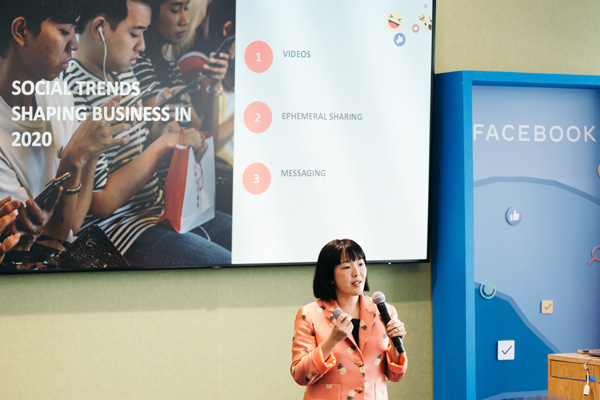A fisherman who uses WhatsApp and Facebook to change his quality of life and keeps his community safe by alerting each other on weather and tide conditions, a non-profit that empowers the homeless towards financial independence by turning them into tour guides, a delicious sambal recipe made in Malaysia that gained acclaim across borders from Indonesia and the Philippines — these are real examples of business innovation previously unimaginable.
The year 2020 crowns a decade of change that has upended traditional ways of starting, marketing and growing businesses across the world. This is even more pronounced in Asia, where entire countries have leapfrogged to the mobile internet, making the region home to some of the world’s fastest-growing economies. According to the Department of Statistics Malaysia, the nations’ digital economy contributed 18.5% to the national economy in 2018, while e-commerce contributed 8%, highlighting digital transformation as a catalyst for expansion.

According to a McKinsey report, by 2040, Asia could account for more than half of the global GDP with global cross-order flows shifting towards Asia. The report shows how these changes could shift globalisation towards regionalisation with 60 percent of goods traded by Asian economies being within the region. In addition, 71 percent of Asian investment in start-ups is intraregional, and 74 percent of Asian travelers travel within the region.
Malaysia’s exports accounts for more than 71.5% of GDP. Digital adoption in increasing productivity is crucial for SMEs to expand further and digital tools give SMEs a boost in economic growth (revenue and sales 65%) and go global (82% of exporting SMEs in Malaysia say that at least half of their exports depend on online tools usage).
Against this backdrop of macroeconomic change, people’s expectations for the experiences they have with brands and businesses is evolving fast. As we have seen over the last few years, people adopt new technologies long before businesses do, and it influences how they discover, research and finally make purchasing decisions.
We see this every day on Facebook, where every day 1.62 billion people across the world come to connect with people, products and services they care about. We stand at the intersection of community and creativity where brands can identify, take inspiration from and participate in the communities that people inhabit. At the start of 2019, we shared three social trends that were on rise across our platforms: ephemeral sharing, videos and messaging. As we head into 2020, these trends have only intensified in our region. Simply put, Asia is about more — more mobile, more video, more stories, more conversation and more commerce.
Malaysia is a truly mobile-first nation with 88% owning smartphones. According to the Malaysian Communications and Multimedia Commission (MCMC), 77.6% of Malaysians are spending time streaming or downloading videos online.
Last year we saw how people show preference for sharing photographs or video over typing out a text update, the comfort of knowing what you post isn’t going to stick around forever and the need to share everyday moments with smaller audiences.

It’s interesting to note that video on mobile is far from a homogenous experience. Unlike traditional video, mobile video experiences are not linear and vary based on a number of factors. Through our research and experience over the last few years, we’ve seen two distinct categories of video experiences that have accelerated largely due to mobile: “on-the-go” and “captivated viewing.” As a result of these changing viewing habits, people are most drawn to brands that are easy to discover and use, whether it’s through their strong presence in online communities or their high-quality mobile content across platforms. With the continued growth in streaming services, people will be looking to brands that can clearly communicate their offerings and to those that can create a more personalised viewing experience.
We’re continuing to see fast adoption of ephemeral sharing as each of our Stories experiences across Facebook, Messenger, Instagram, and WhatsApp now have more than half a billion daily users. As more and more people use Stories, we’re making it easier for marketers to adopt this format and reach people where they’re spending their time.
The same goes for messaging. At the start of 2018, we shared that over 8 billion messages were sent between people and businesses on Messenger every month. That number has more than doubled to 20 billion messages this year – which shows that people expect to communicate with businesses in much the same way as they message with their friends. As people increasingly use messaging apps, we’re helping businesses make the shift too. There are now over 40 million monthly active businesses on Messenger (i.e. sending or receiving a message on Messenger) and research shows that people in emerging countries in Asia-Pacific are more likely than the global average to message a business. In fact, 63% of people surveyed in Asia-Pacific messaged a business last Holiday season. More than 5 million businesses are actively using the WhatsApp Business app each month.
While last year we saw the ability to message with a business made people feel more confident about the brand and more connected to it and create a connection that fosters brand loyalty, this year we see an interesting subset of this preference for messaging; the growing use of messaging or online chat to buy and sell. A study by the Boston Consulting Group in partnership with Facebook across nine countries found that Southeast Asia outpaces other countries surveyed in both awareness and adoption of conversational commerce. Of the nine countries surveyed, the percentage of respondents who had undertaken a conversational commerce transaction was the highest in Thailand and Vietnam, at 40% and 36% respectively, followed by Indonesia (29%), Malaysia (26%) and the Philippines (23%). The rate of adoption for other countries is still nascent – US (5%), Mexico (6%), India (10%), and Brazil (11%), which shows substantial opportunity for growth. The study unveiled a remarkable finding that discovery and spending behavior of digital consumers in between Tier 1 and Tier 2 cities are very similar, debunking the myth that Tier 1 digital consumers shop more online. Once a Tier 2 shopper adopts online shopping, habits and preferences become very similar to Tier 1. Except for the discovery journey, where Tier 2 shoppers don’t know what they want to buy even more, which means they are even more encouraged by inspiration-shopping.
All of these developments mean that the commerce landscape will continue to evolve with people opting to interact with businesses via experiences that are most relevant, personal, and seamless in their daily lives. With increasing affluence and access to the mobile internet, the ways people discover new products is very much about a connected experience. Therefore, ensuring that your business and brands are visible and discoverable is going to be an essential element to winning in the new era of commerce.
Today, Most Malaysian consumers want everything almost immediately, making every step or delay a chance for them to abandon their journeys. Awareness, information gaps and the inability to optimise technology are some causes that contributed to the friction. So what can businesses do to prepare for this new era of commerce? Bring connection back to the equation.
Businesses can enhance connections by designing mobile-friendly websites, apps, marketing and real-time communication to reduce friction and establish the best experiences for customers. This behaviour is reshaping e-commerce in the region, with the emergence of conversational commerce.
Second, they must think about how their internal teams connect so they can better deliver the experiences that customers expect across the full value chain. Thirdly, all of this requires an innovation mindset — being willing to experiment with the new — from AR/VR formats to interactivity, from vertical video to reimagining the channels and platforms on which you can stand out and be discovered.
Finally, measure what matters. The spaces brands have to bring their ideas to life, to earn and keep that attention, have never been bigger, richer, or more connected. Being able to set the right objectives and measure outcomes will help businesses plan for new contexts and create experiences that provide choice, personalisation, interactivity and hyper-relevance.
